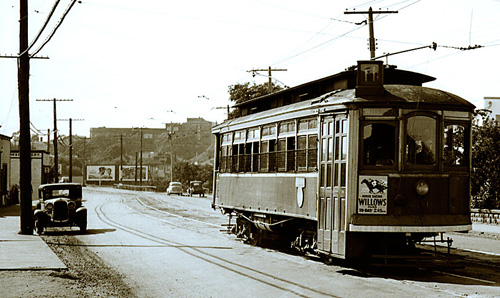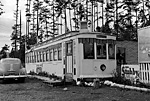|
Willows Streetcar
|
|
Unlike the Oak Bay and Uplands lines
— which were built to accommodate land developers — the Willows line was built to transport paying customers to events at the Willows Fairgrounds |
|
|
|
|
|
| The Willows line originated in 1891 as an extension of the city's Fort Street line to the Jubilee Hospital at Richmond Road. | ||
| The BC Agricultural Association requested that this line be extended a few blocks east to the Driving Park at Willow Road, the new site of the annual fair. The BC Agricultural Association was the sponsor of the fair, which had just relocated from Beacon Hill Park to the Driving Park that year. | ||
| On September 26, 1891, the Driving Park became the new terminus on the city's Fort Street line. Riders on this day attended a gun tournament. They were charged an extra five cents for the short ride between the city limits at Foul Bay Road and the Driving Park. | ||
| Over time the Driving Park became known as the Willows, as more than horse racing was now happening on these grounds. Both terms were used concurrently for years. | ||
| Events at the Willows were dependent on streetcars for patrons. This was made abundantly clear in August 1892 when the rail line powerhouse burned to the ground and all streetcars were grounded. | ||
| This power outage occured during horse-racing season at the Willows and the BC Jockey Association reponded quickly. They received the temporary loan of two streetcar trailers (streetcars without motors) to which they hitched teams of horses and so transported patrons to the races for the duration of the power outage. | ||
| During this emergency, horsedrawn omnibusses were also employed to transport patrons to the races, but not without incident: | ||
|
||
| In 1902 the track between Oak Bay junction and the Willows was completely relaid. | ||
| In 1909 a terminus loop was created at the Willows by building a return track through a right-of-way that would become Fair Street. | ||
| In 1910 a development company, Uplands Limited, had plans to develop an upscale garden community — The Uplands. By 1912 the streets were constructed and a few impressive houses had been built to set the tone. Uplands Limited then approached the tram company with a request to extend the rail line from the Willows to the Uplands. The request was supplemented with a financial contribution of $1,817.13 for track laid within the Uplands.2 | ||
| In 1913 the Fort Street line was extended from the Willows to the Uplands, with Midland Circle becoming the new terminus. Streetcars running from town to the Uplands terminus were designated Uplands. | ||
| The Willows line served the community until January 31, 1948, after which time city and municipal streetcar tracks yielded to the more flexible routing of busses. | ||
|
|
||
| 1 Parker, Douglas V. No Horses in Paradise: A History of the Streetcar Railways and Public Utilities in Victoria, British Columbia before 1897. (Whitecap Books:1981) p 50. The extension of Fort Street east of the city limits at Foul Bay Road was a dirt road on private property. Immediately east of Foul Bay Road was a small bridge over Bowker Creek. | ||
| 2 Ewert, Henry. Victoria's Streetcar Era. (Sono Nis Press:1992) p 54. | ||
Streetcar Fare . . . |
||
| Streetcar service in Victoria began on February 22, 1890. Each car was staffed with a motorman (sometimes called a motorneer) and a conductor who, among other resposibilities, collected fares. The fare was five cents. | ||
| In 1890, the first year of operation, it was decided to issue transfers to allow passengers to connect with other lines (within 30 minutes of issuance). | ||
| In 1894 designated stops were introduced. Prior to this passengers could get on and off wherever they pleased. | ||
| In 1909 the PAYE (pay as you enter) system was introduced. Prior to this, fares were collected by the conductor (who wore a change dispenser clipped to his belt). The PAYE system necessitated exact fare, as change was no longer being made. | ||
| In 1937 BC Electric's fifty-year franchise to provide streetcar service in the city (including the Oak Bay runs) was due to expire. By this time it was obvious to all that busses would replace streetcars. In fact there were already several bus routes in the city. But then WW II happened and gas and rubber were rationed, obligating the city and municipalities to extend the service of streetcars indefinitely. Streetcar service ended in Oak Bay on March 2, 1948 (the Oak Bay line), and in the city on July 5, 1948. | ||
|
* * * |
||
| The year 1948 marked the end of an era in both Oak Bay and Victoria. Not only did streetcars become history, but so too did the Willows Fairgrounds after several exhibition buildings were destroyed by fire in that same year. Almost overnight a romantic era was replaced with the hustle of post-war boom years and the servicing of suburbia. | ||
| FURTHER READINGS | ||
| Ewert, Henry. Victoria's Streetcar Era. (Sono Nis Press:1992) | ||
| Kelly, Brian and Daniel Francis. Transit in British Columbia: The First Hundred Years. (Harbour Publishing:1990) | ||
| Parker, Douglas V. No Horsecars in Paradise: A History of the Street Railways and Public Utilities in Victoria, British Columbia before 1897. (Railfare/Whitecap:1981) | ||
|
PHOTOGRAPHS
|
Click on image to view enlargement
|
Epworth Street
|
Willows Diner
|
Do you have any photos of the Willows streetcar?
If yes, please share them by using the form below
|
ARTIFACTS
|
Do you have any Willows streetcar artifacts?
TRANSFERS. PROMOTION, ETC
If yes, please specify in the form below
|
RECOLLECTIONS
|
Recollections may be abridged for length and/or clarity
| My father dug up a spike from the streetcar line on Fair Street. That was in 1954. Today (2013) I dug up a spike at an excavation next to Oak Bay school. |
| — Joe McAnally, former Oak Bay resident |
Do you have any recollections of the Willows streetcar?
If yes, please share them by using the form below
|
SUBMISSIONS
|
|
Do you have any
photos, artifacts or recollections of the Willows streetcar? |
|
PLEASE CONTACT US Your contribution may become part of Oak Bay history! |
|
You can email us, with attachments if available |
|
OR
|
|
You can use the Online Submission Form, below
|
Thank You!
Return to section "W" of the Encyclopedia
The History of Oak Bay Website
A CENTENNIAL LEGACY PROJECT



